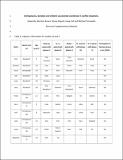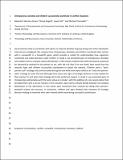Files in this item
Chimpanzees, bonobos and children successfully coordinate in conflict situations
Item metadata
| dc.contributor.author | Sánchez-Amaro, Alejandro | |
| dc.contributor.author | Duguid, Shona | |
| dc.contributor.author | Call, Josep | |
| dc.contributor.author | Tomasello, Michael | |
| dc.date.accessioned | 2018-06-07T23:32:01Z | |
| dc.date.available | 2018-06-07T23:32:01Z | |
| dc.date.issued | 2017-06-14 | |
| dc.identifier | 249973596 | |
| dc.identifier | a8ab74d0-d0a7-402d-9e54-05f65fe03ae7 | |
| dc.identifier | 85020446042 | |
| dc.identifier | 000405955300005 | |
| dc.identifier.citation | Sánchez-Amaro , A , Duguid , S , Call , J & Tomasello , M 2017 , ' Chimpanzees, bonobos and children successfully coordinate in conflict situations ' , Proceedings of the Royal Society B: Biological Sciences , vol. 284 , no. 1856 . https://doi.org/10.1098/rspb.2017.0259 | en |
| dc.identifier.issn | 0962-8452 | |
| dc.identifier.other | ORCID: /0000-0002-8597-8336/work/37477993 | |
| dc.identifier.uri | https://hdl.handle.net/10023/13831 | |
| dc.description | A.S. was partially supported by a LaCaixa-DAAD grant (13/94418). J.C. was partially supported by an ERC-Synergy grant SOMICS grant 609819. Data available from the Dryad digital depository: http://datadryad.org/review?doi=doi:10.5061/dryad.8638h | en |
| dc.description.abstract | Social animals need to coordinate with others to reap the benefits of group-living even when individuals' interests are misaligned. We compare how chimpanzees, bonobos and children coordinate their actions with a conspecific in a Snowdrift game, which provides a model for understanding how organisms coordinate and make decisions under conflict. In study 1, we presented pairs of chimpanzees, bonobos and children with an unequal reward distribution. In the critical condition, the preferred reward could only be obtained by waiting for the partner to act, with the risk that if no one acted, both would lose the rewards. Apes and children successfully coordinated to obtain the rewards. Children used a ‘both-partner-pull’ strategy and communicated during the task, while some apes relied on an ‘only-one-partner-pulls' strategy to solve the task, although there were also signs of strategic behaviour as they waited for their partner to pull when that strategy led to the preferred reward. In study 2, we presented pairs of chimpanzees and bonobos with the same set-up as in study 1 with the addition of a non-social option that provided them with a secure reward. In this situation, apes had to actively decide between the unequal distribution and the alternative. In this set-up, apes maximized their rewards by taking their partners' potential actions into account. In conclusion, children and apes showed clear instances of strategic decision-making to maximize their own rewards while maintaining successful coordination. | |
| dc.format.extent | 615227 | |
| dc.format.extent | 1188457 | |
| dc.language.iso | eng | |
| dc.relation.ispartof | Proceedings of the Royal Society B: Biological Sciences | en |
| dc.subject | Coordination | en |
| dc.subject | Conflict | en |
| dc.subject | Snowdrift | en |
| dc.subject | Chimpanzees | en |
| dc.subject | Bonobos | en |
| dc.subject | Children | en |
| dc.subject | BF Psychology | en |
| dc.subject | DAS | en |
| dc.subject.lcc | BF | en |
| dc.title | Chimpanzees, bonobos and children successfully coordinate in conflict situations | en |
| dc.type | Journal article | en |
| dc.contributor.sponsor | European Research Council | en |
| dc.contributor.institution | University of St Andrews. School of Psychology and Neuroscience | en |
| dc.contributor.institution | University of St Andrews. Centre for Social Learning & Cognitive Evolution | en |
| dc.identifier.doi | 10.1098/rspb.2017.0259 | |
| dc.description.status | Peer reviewed | en |
| dc.date.embargoedUntil | 2018-06-07 | |
| dc.identifier.grantnumber | 609819 | en |
This item appears in the following Collection(s)
Items in the St Andrews Research Repository are protected by copyright, with all rights reserved, unless otherwise indicated.


